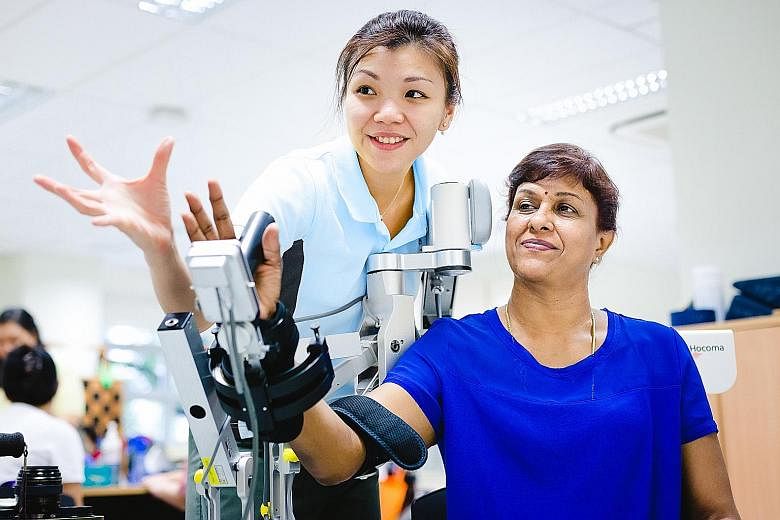It can feel a bit tingly when Bioness touches your hand.
For she will send electrical pulses to your forearms.
Bioness does that for a reason - it is a rehabilitation robot that helps post-stroke patients strengthen the use of their hands, such as to grasp and release a slice of bread, speeding up their recovery.
Bioness is one of three robots rolled out by St Luke's Hospital in Bukit Batok since January last year as part of its tailored treatment sessions for patients.
Mr Gribson Chan, deputy director of the hospital's rehabilitation services division, said: "With the robotic automation, we see 20 per cent more improvement in the upper limb functions of patients than those who undergo conventional treatment. We can also serve 20 per cent more patients."
The robot project was funded by the Agency for Integrated Care's (AIC) Healthcare Productivity Fund. It was one of about 30 projects recognised at the Intermediate and Long-Term Care Excellence Awards yesterday.
The biennial awards, introduced by the AIC in 2014, recognise community healthcare professionals and organisations for their work in delivering quality care and service to their clients.
There are six broad award categories - three for outstanding staff members, and three for teams that implemented outstanding projects in the areas of service quality, improvement in productivity and innovation, among others.
There were more than 200 recipients from 23 organisations. They included clinical professionals, administrators, care staff and heads of community hospitals, nursing homes and hospices.
Winners included Orange Valley Nursing Home in Sims Avenue, which created a kampung-style garden area to engage residents' five senses. For instance, flowers engage their sense of smell. The home won a merit award for productivity and innovation.
Touch Seniors Activity Centre picked up an award for improving its service quality. It recruited its more able senior clients as volunteers to befriend and support frail and homebound seniors in the community. There are 57 volunteer seniors who have befriended about 60 homebound seniors since the project started in October 2013.
Senior Minister of State for Health and the Environment and Water Resources Amy Khor, who officiated at the event, said the focus will continue to be on improving quality as services are ramped up to meet the needs of Singapore's ageing population. She noted that by 2030, there will be more than 900,000 seniors aged 65 and over.
"Patients' expectations of care are increasingly rising... We are growing capacity across home, centre-based and nursing-home care to ensure our seniors can access care when they require it," she said.
She cited several ways in which the Government has been encouraging more quality community care.
For example, it is in the process of awarding about $8 million to projects under its Care-at-Home Innovation Grant. This falls under the $200 million set aside for the National Innovation Challenge on Active and Confident Ageing.
Dr Khor said the Government has other initiatives that support and fund projects dedicated to improving community care. For instance, 90 per cent of the 70 or so nursing homes here have worked with the AIC to review and streamline their work processes since 2014.
Financial support for the sector is also available through AIC's Healthcare Productivity Fund, which supports initiatives to adopt technology and conduct training and skills upgrading, among other things.


